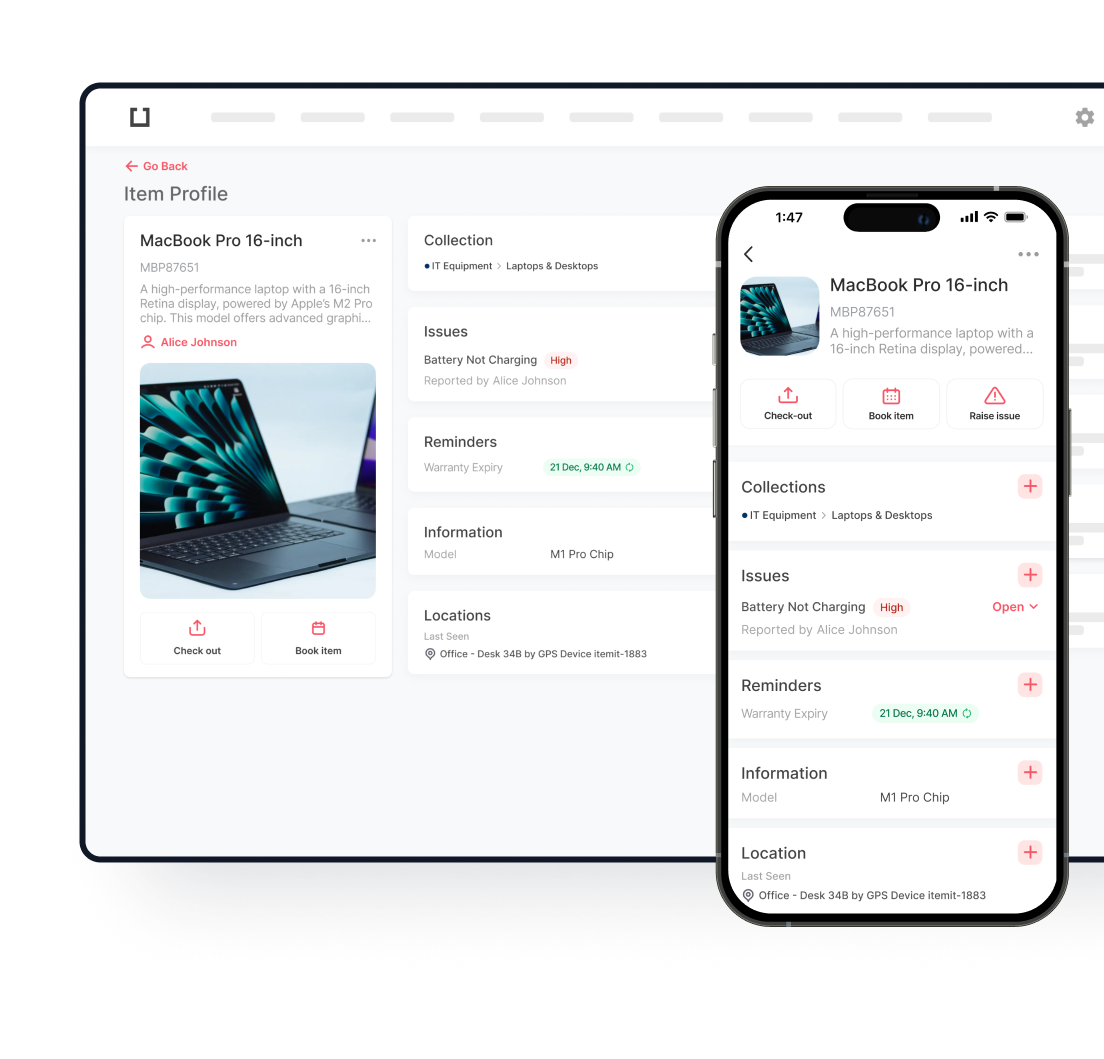
Every single business on the planet has assets. Some businesses may have thousands of assets. Some may only have a few. Regardless of how many assets they have, ghost assets may be an issue. Assets such as these can cause a business to undervalue itself. Additionally, they can also cause workflow issues resulting in deadlines not being met. A realistic way to tackle the issue of ghost assets is by using asset tagging software. Software such as this can identify and potentially rid your business of this type of asset.

What Is A Ghost Asset?
What is a ghost asset exactly? In simple terms, ghost assets are items that appear on a company’s books but cannot be accounted for in reality. This concept is related to ghost inventory, though ghost inventory specifically refers to stock items that exist in records but not physically in your warehouse. These are physical assets that may be lost, stolen, damaged beyond repair, or otherwise unusable, yet still recorded as active on the company’s balance sheet.
Common examples of ghost assets include:
- Equipment that has been discarded without proper documentation
- Technology that’s obsolete but still listed as functional
- Vehicles that have been decommissioned but remain on the books
- Tools that have disappeared from job sites
- Office equipment that’s been relocated without tracking
Up to 30% of a company’s fixed assets could be ghost assets. This means businesses may be paying insurance, taxes, and maintenance costs on items that no longer exist or function within their organisation.
What Is The Issue With Ghost Assets?
When you have ghost assets, your business could be significantly underperforming in multiple ways. Ghost assets are any type of asset that could be lost or stolen. Additionally, they could be assets that are awaiting repair or awaiting replacement without your knowledge. In other words, these are printers, photocopiers, tools, machines, trucks, equipment, and so on that are still thought to be in working order. Unfortunately, as soon as they become lost, stolen, or damaged, they can cause various financial and operational issues.
Financial Implications
- Overpayment of insurance premiums for non-existent assets
- Inflated property tax assessments
- Inaccurate depreciation calculations
- Overstatement of company value on financial statements
- Poor investment decisions based on incorrect asset valuations
- Compliance risks with financial reporting regulations
Operational Challenges
- There’s a real possibility that a customer’s order may not be completed on time
- Deliveries may not be made when expected
- Production may slow down due to missing equipment
- Maintenance schedules become disrupted
- Your business may not meet its financial goals
- Resources are wasted searching for missing assets
- Unnecessary duplicate purchases to replace items that can’t be found
Whatever the case may be, ghost assets can pose a real issue to businesses of all sizes. This is why locating and dealing with ghost assets by using ghost tracking software is a priority. The really good news is that this type of software ghost asset management solution can realistically help you identify and eliminate these phantom assets.
Types of Ghost Assets
Ghost assets typically fall into several categories, each requiring different approaches to identification and management:
Physically Missing Assets
- Lost or misplaced equipment
- Stolen items
- Assets removed from premises without documentation
Functionally Obsolete Assets
- Technology that’s outdated but still in the books
- Equipment that no longer meets industry standards
- Assets that have been replaced but not recorded as such
Damaged Beyond Repair
- Equipment destroyed in accidents
- Assets deteriorated beyond usable condition
- Items awaiting disposal but still recorded as active
Phantom Transfers
- Assets moved between departments without documentation
- Equipment relocated to different facilities without tracking
- Items loaned to employees or contractors without records
Ghost IT Assets
- Decommissioned servers still on inventory
- Outdated software licenses still being paid for
- Virtual assets that no longer exist
Understanding the type of ghost assets affecting your organisation is crucial for implementing the appropriate ghost-tracking equipment and procedures to address them.
Industries Most Affected by Ghost Assets

While all businesses with physical assets can suffer from ghost asset problems, certain industries are particularly vulnerable:
Manufacturing
Manufacturing facilities often have thousands of tools, machines, and equipment pieces that can easily become ghost assets without proper ghost tracking systems. The fast-paced environment and multiple shifts can lead to items being misplaced or damaged without documentation.
Construction
Construction companies face unique challenges with assets constantly moving between job sites. Without a robust ghost tracking device system, tools and equipment can disappear or remain on closed job sites, becoming ghost assets that still appear on financial statements.
Healthcare
Medical equipment is expensive and frequently moved throughout facilities. Hospitals and clinics without proper ghost tracking app solutions can lose track of valuable assets, leading to significant financial discrepancies.
Transportation and Logistics
Fleet vehicles, trailers, and shipping containers can become ghost assets without proper ghost car tracking systems. Companies may continue paying insurance and maintenance costs for vehicles that have been decommissioned or sold.
Education
Schools and universities manage numerous assets across sprawling campuses. Without proper tracking, equipment can be moved between departments or buildings and effectively become ghost assets.
How Can Asset Tagging Software Help?
Asset tagging software can help in a variety of ways. Firstly, it can help you to have a clear record of all of your assets. As long as you have added every single tool, machine, vehicle, etc., to the software, you’re good to go.
A comprehensive ghost tracking system provides several key benefits, especially when you implement asset tracking with easy solutions designed for businesses of all sizes.
Complete Asset Visibility
- Real-time location tracking of all assets
- Historical movement records
- Usage patterns and efficiency metrics
Automated Auditing
- Regular automated checks against inventory records
- Flagging of potential ghost assets
- Simplified physical audit processes
Maintenance Management
- Scheduled maintenance notifications
- Repair history and status tracking
- End-of-life projections and replacement planning
Financial Accuracy
- Current asset valuation reports
- Precise depreciation calculations
- Insurance requirement adjustments
Software such as this can help you to locate your tools but also see which assets aren’t being used. When you’re entering every asset into the system, you have a good idea as to which tools work. When you find a tool, a machine, or a vehicle, for example, that does not work, you can take immediate action. You could, for example, send it to maintenance to be repaired. Alternatively, you could simply note that the machine needs to be discarded or replaced.
Once you have added everything to the system by creating digital profiles for each asset, most of the work is done. You could have a full and complete record of everything your business owns. A result of this means that you now have a much clearer picture. You could see exactly how many tools you have and even where they are located. Asset tagging software can also ensure that you’re a lot less likely to have ghost assets again. This is simply because the software could help you to send those damaged tools to maintenance for repairs. Should a machine be completely broken, you could tell the relevant people via the software. All of this could help to prevent future issues.
Key Features of Ghost Tracking Software
Modern ghost tools and tracking systems offer sophisticated features designed specifically to eliminate ghost assets:
- RFID Technology
Radio-frequency identification allows for wireless tracking of assets without direct line-of-sight. RFID ghost tracking equipment can automatically register when assets move through specific checkpoints, providing passive monitoring capabilities.
- GPS Integration
For mobile assets, GPS-enabled ghost car tracking and equipment tracking provide real-time location data, allowing businesses to pinpoint the exact location of valuable assets at any time.
- Barcode and QR Systems
More affordable tracking options include barcode and QR code systems that require physical scanning but provide reliable identification and status updates for assets.
- Cloud-Based Asset Management
Modern ghost tracking app solutions store data in the cloud, allowing access from anywhere and ensuring information remains current across all departments and locations.
- Automated Alerts and Notifications
Sophisticated software ghost asset management systems can send alerts when assets haven’t been scanned or moved within expected timeframes, flagging potential ghost assets before they impact operations.
- Integration Capabilities
The best ghost asset tracking systems integrate with other business software, including accounting systems, ERP platforms, and maintenance management tools.
How To Say "Goodbye" To Ghost Assets
So how can you say “Goodbye” to ghost assets? It’s fairly easy. Simply use asset tagging software to track your machinery, vehicles, equipment, facilities, tools, and anything else. Here’s how to go about it:
Create an asset register
- Conduct a thorough physical inventory
- Document all existing assets with photographs
- Cross-reference with financial records to identify discrepancies
Implement tracking technology
- Make sure that you add an RFID tag or a barcode to each asset so its location can be tracked
- Consider GPS trackers for high-value mobile equipment
- Install ghost tracking device readers at key locations throughout your facilities
Build comprehensive digital profiles
- Start adding details to each asset’s digital profile, such as its make and model
- Include insurance and warranty information
- Document purchase date, value, and expected lifecycle
- Consider uploading a PDF instruction manual if there is one
- Record maintenance history and requirements
Establish preventative maintenance
- Set up a maintenance schedule to help prevent assets from falling into a poor state of repair
- Create automated maintenance reminders
- Document all repairs and servicing
- Evaluate repair costs against replacement value
Implement regular monitoring
- Track the location of your tools and anything else you use every day
- Conduct regular audits using your ghost tracking system
- Compare physical counts with system records
- Investigate discrepancies immediately
Develop accountability protocols
- Give your trusted team members access to the tagging software so they can track everything, too
- Establish clear responsibility for asset custody
- Create check-out/check-in procedures for shared equipment using dedicated equipment checkout software that maintains complete audit trails
- Train staff on proper asset management procedures
Analyse and optimise
- Review utilisation rates for expensive equipment
- Identify underused assets that could be redeployed
- Recognise patterns of loss or damage to address root causes
- Use data to inform future purchasing decisions
As soon as you have done all of the above, you are good to go. You could start using the software immediately. If you do, you may be able to see the maintenance status of all of your assets. You can see where they are and which team member is using them. Depending upon the tagging software you choose, you may also be able to export reports based on data. The reports can give you a much clearer idea about how well your business is running. It could also help you to see if there are any maintenance issues, allowing you to resolve the issues immediately.
Transform Your Asset Management Today
Ghost assets represent a significant but often overlooked challenge for businesses of all sizes. By implementing a robust ghost tracking system, companies can gain accurate visibility into their asset inventory, improve financial reporting, enhance operational efficiency, and ultimately increase profitability.
The key to success lies in choosing the right ghost tracking app or software solution that meets your specific business needs, then maintaining disciplined processes to ensure all assets are properly tracked throughout their lifecycle. With the right tools and procedures in place, you can confidently say goodbye to ghost assets and the problems they create.
Wish to chat with an expert about using asset tagging software to help you eliminate ghost assets? Contact us now at team@itemit.com.

Try itemit
Choose a better way to track your assets. Start your free 14-day trial now!

Keep Learning
itemit Blog
Tips, guides, industry best practices, and news.
Why You Need To Use A Hardware Asset Management Tool
Is managing your hardware assets tricky? Read this article to find out why using a hardware asset management tool is the way forward.
Why Managing Assets In The Cloud Makes Life Easier
Managing assets in the cloud by using an ICT asset register can make life so much easier. Read this article now to find out why and how!
5 Tips For Reducing Asset Downtime
Want 5 tips for reducing asset downtime regardless of which asset register format you use? Read our latest blog post now!




